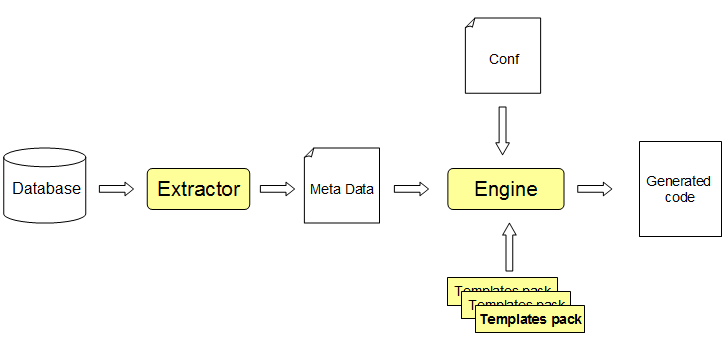1. Introduction
Celerio
Celerio is a code generator designed to generate the foundation of data oriented applications.
Celerio is distributed as a Maven plugin which greatly eases its integration in your project development.
Celerio itself is written in Java. It executes generation templates that produce some source code: Java files, XML files, etc. The generation templates are written in Velocity. Jaxio provides ready-to use templates so you can focus on real business needs but you may also creates your own generation templates.
Celerio uses an entity-relationship model as a starting point. This model can be produced by any tool as long as the tool respects Celerio’s expected format. In practice Jaxio provides a tool that extracts an existing database schema to produce the initial model. Of course this entity-relationship model can be refined by configuration.
Celerio is composed of three main components:
- a database schema extractor tool
- the core Celerio Engine
- some template packs.
Database Schema Extractor tool
This tool reverses an existing database schema using the JDBC Meta Data API. It connects to your database, and extracts the various meta-information such as tables’ name, columns’ name, constraints, relations, comments, etc. The extraction result is written in an XML file. This tool runs in a read only mode, it does not read your real data or modify your database.
Celerio Engine
Celerio Engine relies on the raw entity-relationship model extracted by the database schema extractor tool and a configuration file which instructs Celerio how to refine this model.
Indeed, the extracted model does not carry all the meta information, it is up to you to enrich it.
For example, through configuration, you may add inheritance to your model. From this enriched model, Celerio constructs a graph into memory and let the generation templates access to it when it executes them.
Template packs
The generation templates that Celerio executes are grouped into jar files called templates packs.
Jaxio provides some Open Source template packs, but again, you can write your own:
- Angular 4 with PrimeNG + SpringBoot: https://github.com/jaxio/celerio-angular-quickstart
- pure Java EE 7 (backend + frontend, without Spring): https://github.com/jaxio/javaee-lab
- backend templates (with Spring): https://github.com/jaxio/pack-backend-jpa
- frontend templates (with Spring): https://github.com/jaxio/pack-jsf2-spring-conversation
Celerio loads all the template packs found on the classpath, so make sure you add them as jar dependencies when executing Celerio.
By default Celerio executes all the templates found in a pack, but this can be configured to filter out certain templates.
The templates packs are regularly updated to take into account the latest industry standards and practices. The current template packs generate some source code that uses the following frameworks or standards: JSF2, SpringFramework, JPA2, Bean Validation, PrimeFaces, etc.

The generated source code follows industry standards and best practices. It is organized into a project structure following the Maven conventions.
Celerio also uses some conventions. If you follow them, you can reduce the amount of configuration.
The Database Schema Extractor and Celerio Engine are distributed as Maven plugins, which simplifies their installation and make them compatible with IDE that already support Maven integration. Eclipse, Netbeans and IntelliJ have outstanding Maven support.
Celerio allows you to replace, skip, modify or extend the generated source code allowing you to use Celerio in an iterative development.
Last but not least, Celerio is not required at runtime. There is no lock-in.
When to use Celerio?
Celerio targets applications that use a relational database and whose database schema is close to the domain layer. From there Celerio may be used for different purposes.
Spread your best practice and architecture
New templates packs can be easily developed to take into account your in-house libraries and company best practices. Once these packs are ready, they can be deployed as any other jar in your private Maven repository and be used by your different teams to develop their applications based on your best practices and architecture.
Application Rewriting
Deciding to rewrite an application in Java is a tough decision. There are often many risks. However, when your end users ask for patches and features that you cannot deliver in time because of some some old code that nobody understand anymore, you do not have many choices. But it is too much work, you would need a second team or more time, but there is no budget for that.
Celerio helps your existing team to make the first move toward your application rewriting and support your team during the application development cycle.
Rapid prototyping
Writing a prototype for free is a common practice in the industry. You have to work fast, for free, and deliver top notch quality to get the deal. Celerio increases drastically your chances to succeed, it gives you the possibility to prototype extremely fast with no compromise on quality and architecture.
New application
Writing an application from scratch is also possible with Celerio. Instead of designing your domain layer in Java, you directly design you database schema.
Training
Finally, the code generated by Celerio may be used as training material. The code is readable, well organized, unit tested and documented. Developers should learn from it.
What to expect from Celerio?
You can expect a 30% gain on your application development.
However it is important to understand that Celerio is not here to replace your developers’ brain. So do not count on Celerio to do all the smart job. Instead Celerio is here to let your developers focus on the real value of your final application. Celerio automates the tedious and repetitive task of writing the backbone of your Java project.
Not smart, but not dumb either, Celerio goes way beyond a simple copy paste. It covers subject such as persistence, inheritance, 2d level cache, security, dependency injection, distribution, localization, unit tests, etc.
© 2005-2015 Jaxio | @jaxiosoft | Legal